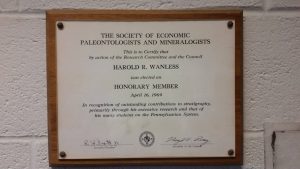Harold Rollin Wanless was a busy man. In addition to being a professor at the University of Illinois, he also conducted research and was a member of many professional societies. Professor Wanless was President of the Illinois academy of Science in 1938, Senior Research Fellow in Australia in 1958-59, President of U.I. Chapter of Sigma Xi in 1964-65, Distinguished Lecturer of the American Association of Petroleum Geologists in 1956, and an invited lecturer at the British Association for the Advancement of Science in 1967 and at the Sixth International Carboniferous Congress in England in 1967. He was a member of a great many international geological congresses, in which he took active part in sessions and field excursions. He was also active with the Illinois State Geological Survey. He served as a Geologist in 1954. In addition, he was a Consultant on Pennsylvanian stratigraphy for the United States Geological Survey. He was also a holder of research project grant for study on environmental mapping of Pennsylvanian strata and mapped each unit of a sequence for the 1963-65 United States Coast and Geodetic Survey. He was also involved in a project with University of Illinois on study of coastal changes revealed by successive dates of aerial photography. He was also employed outside of the United States. He was Senior Fulbright Research Fellow to University of Sydney, Australia, 1958-59, for study of late Paleozoic glacial deposits of Australia. He did work outside of geology as well, as he served the University of Illinois Committee on Aerial Photography as Chairman from 1962 to 1964. He did not do as much work with businesses since he was preoccupied with other commitments but he was a Consultant to three major oil companies and two gas storage companies nonetheless.

Pictured above is an award from The Society of Economic Paleontologists and Mineralogists stating that “by action of the Research Committee and the Council Harold R. Wanless was elected an honarary member April 16, 1969, In recognition of outstanding contributions to stratigraphy, primarily through his extensive research and that of his many students on the Pennsylvanian System.

